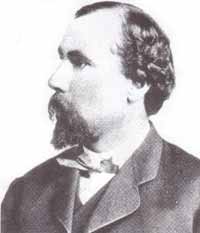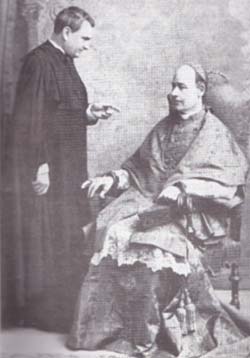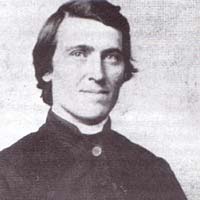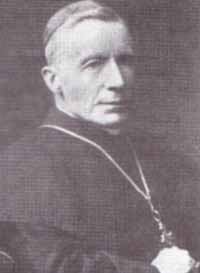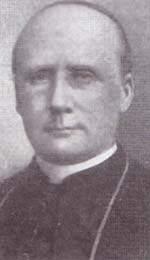Heresy in the Making, Part II
Part 2
THE GESTA DEI PER HIBERNOS 1860-1889
Dr. Justin Walsh
When Minnesota entered the union in 1858 as the 32nd State there were 60,000 residents mostly concentrated along the Upper Mississippi from the Twin Cities south to the Iowa border. Otherwise the state was mostly an unsettled wilderness in need of population. If settlers came, the wilderness would be carved up into counties and good times would roll with law and order, a county seat, courthouse, commissioners, a sheriff, a jail, and judges. Businesses, schools, churches, and the other amenities of American democratic civilization would soon follow. If a man of vision looked north and west from St. Paul between 1865 and 1890, the potential was clear.
|
James J. Hill, 1963 |
James J. Hill, the railway tycoon, was a man of exactly such vision, as was John Ireland, the Churchman. Hill began to monopolize rail traffic to all points west when he manipulated stocks to secure control of the bankrupt St. Paul and Pacific Railroad during the Panic of 1873. He obviously saw beyond Minnesota through the wide open spaces of the Great Plains all the way to the Pacific Coast. Hill's purview saw potential states in this unorganized wilderness, states created by people whose presence guaranteed prosperity for his railroads.
Enter John Ireland, a Churchman with promotional talents and a colonization scheme. Ireland promised to bring Catholics West with the lure of cheap land under terms of the federal Homestead Act of 1862. But Hill would have to provide low-cost transport from the old World and print the promotional brochures.1 If the plan succeeded, Ireland's power would grow because a stable population would need Irish priests, and eventually Irish suffragan bishops of the St. Paul Archdiocese.
By the 1890s both men had what they wanted. Hill's reward was that he became the wealthiest railroad magnate in America. For his part, Ireland saw the Church in Minnesota and the new states of North Dakota and South Dakota staffed almost exclusively by Irish priests and bishops from the Archdiocese of St. Paul. If Ireland should perchance receive the Red Hat of a Cardinal, Montana, Wyoming, Idaho, and Washington would also be under his wing.
The elevation of Irishmen John Shanley of Jamestown, SD, Thomas Cotter of Winona, MN, and James McGolrick of Duluth, MN, is worthy of special note because it illustrates Ireland's peculiar modus operandi. All three were consecrated by the Archbishop on Dec. 27, 1889, in a ceremony that:
...was unique in the annals of the American church up to that time: never before had three men from the same diocese been elevated to the episcopate for service in the same province. Preacher of the day was the Paulist, Walter Elliott, just then finishing his biography of Isaac Hecker. In attendance was Monsignor Denis J. O'Connell, who...delivered a short but graceful address: "Never before in the history of the Church has a province bloomed as rapidly as St. Paul's. Its growth is typical of the American Church."2
|
Denis J. O'Connell with Serafino Cardinal Vannutelli |
Other Irishmen consecrated as bishops by Ireland in his Irish fiefdom included Martin Marty of Sioux Falls, SD, James O'Reilley of Fargo, ND, Patrick Heffron of Winona, and Timothy Corbett of Crookston, MN.
At the First Vatican Council, 1869-1870, John Ireland enjoyed his first encounter with the Baltimore nexus of Americanism. He attended as proctor for Bishop Thomas Grace, who was ill. As a proctor Ireland could not participate in Council sessions, but he could socialize with the 48 American bishops in attendance. This alone made the trip to Rome worthwhile for an ambitious 31-year-old priest from a remote frontier diocese. James Gibbons, vicar apostolic of North Carolina, was among the prelates Ireland met. Gibbons in turn introduced Fr. Ireland to Fr. Isaac Hecker, also present as a proctor. The three must have recognized immediately that they were kindred spirits.3 It is certain that they promoted one another's interests for the rest of their lives.
Fr. Hecker, who possessed many of the qualities John Ireland most admired, received the prelate's warmest encomiums posthumously. Since "the founder of the Paulists was as devoted as the archbishop...to the double mission of converting America to Catholicism and, at the same time, incorporating into Catholic life the best features of the American ethos," Ireland agreed to write the introduction to Elliott's biography of Hecker. In it the Irish-American Archbishop, who seemed to find German Catholics especially distasteful, nonetheless described a German-American priest as "the type that we wish to see reproduced among us in widest proportions."
|
John Ireland in 1862 |
Ireland accepted Hecker because he felt the Paulist was "the ornament, the flower of the American priesthood." Ireland added that different centuries call for different types of Christian perfection: "At one time it was martyrdom; at another it was the humility of the cloister." It was Hecker's genius, wrote Ireland in 1891, to see that Church and State were now most in need of "the Christian gentleman and the Christian citizen." Ireland ended his Introduction with a democratic flourish that French critics saw as blasphemous when the biography was translated into their language: "An honest ballot and social decorum among Catholics will do more for God's glory than midnight flagellation's and Compostellan pilgrimages."4
After the Council Gibbons and Ireland corresponded regularly. When the latter, at age 36, was named bishop of St. Paul in 1875, Gibbons offered hearty congratulations. After Gibbons became archbishop of Baltimore in 1877, he issued a pastoral letter commending the observance of Thanksgiving Day by Catholics. His interest in Ireland intensified when the Minnesotan said publicly that Catholics should celebrate the Puritan feast day. Up to this time the holiday had been largely Protestant. Most importantly, when Gibbons the Americanist organized the Third Plenary Council of Baltimore he assigned leading roles to John Ireland and John Lancaster Spalding.
The Bishops of St. Paul and Peoria journeyed together to Baltimore in 1884. Each prelate had received a special assignment from Cardinal Gibbons and they polished their respective speeches while en route. They traveled first-class, in a private car courtesy of James J. Hill, the St. Paul railroad tycoon.
|
James Cardinal Gibbons
|
Ireland took center stage first, on Monday, November 10, the day of the opening session. After evening Benediction, the Bishop of St. Paul, at the designation of Gibbons, delivered a 90-minute address. The subject, "suggested" by Gibbons, was "The Church—the Support of Just Government." By all accounts the talk was delivered with great elocution and it became known ever after in Americanist circles as simply "The Speech." The conclusion, delivered with suitable fervor—some said patriotic bombast—made the phrase Esto perpetua! (Live forever!) famous as John Ireland became the sensation of the Council:
Republic of America, receive from me the tribute of my love and of my loyalty. I am proud to do thee homage, and I pray from my heart that thy glory may never be dimmed. Esto perpetua!
Thou bearest in thy hands the brightest hopes of the human race. God's mission to thee is to show to nations that man is capable of the highest liberty. Oh! be ever free and prosperous that liberty triumph over the earth from the rising to the setting sun. Esto perpetua!
Believe me, no hearts love thee more ardently than Catholic hearts...no tongues speak more honestly thy praises than Catholic tongues; no hands will be lifted up stronger and more willing to defend, in war and peace, thy laws and institutions than Catholic hands. Esto perpetua!5
It is possible that Ireland, in wishing that American liberty triumph "from the rising to the setting sun," was inadvertently equating the Republic of America with the Holy Sacrifice of the Mass as prefigured by the Prophet Malachias in the Old Testament: "For from the rising of the sun to the going down, my name is great among the Gentiles, and in every place there is a sacrifice, and there is offered to my name a clean oblation: for my name is great among the Gentiles, with the Lord of hosts" (Mal. 1:11).
That an American bishop, a successor of the Apostles, would so dethrone Christ the King at a national meeting of bishops and replace Him with the Republic of America as holding the "brightest hopes of the human race" is prima facie evidence of the Americanist heresy.
John Lancaster Spalding was assigned to sell the idea of a Catholic University to the assembled hierarchy. This had been an Americanist priority since a feasibility study was approved by the Second Plenary Council. Spalding entitled his speech "Higher Education" and on the evening of November 16 he spoke after Benediction:
When our zeal for intellectual excellence shall have raised up men who will take their place among the first writers and thinkers of their day their very presence will become the most persuasive of arguments to teach the world that no best gift is at war with the spirit of the Catholic faith....6
The bishops listened to Spalding and voted to build a university for themselves in Washington, D.C.
Denis O'Connell returned to Rome in 1885 to lobby for approval of the university. In 1887 John J. Keane resigned as bishop of Richmond to become founding rector. Keane also recruited a faculty and by early 1889 he could boast that he had a half dozen "first class" European professors. When he proposed a Roman candidate for the chair of canon law, however, Keane raised O'Connell's ire. The man was "an enemy, a spy, a meddler of the most dangerous character," O'Connell said because "such would surely be any man in Rome in that line of study especially." Instead O'Connell wanted a priest from New Jersey who was "a prodigy of industry and of learning...and heartily an American." Keane acquiesced and hired O'Connell's friend.7
|
Archbishop Keane |
Rome appointed John Gibbons to preside at the Third Plenary Council in the absence of an Apostolic Delegate. Until his death the prelate considered his direction of the Council the crowning achievement of his career. American Catholics remembered it best for the famous Baltimore Catechism, commissioned by the assembled bishops. No child in parochial schools between 1885 and 1960 would ever forget its first question and answer: "Why did God make me? To know Him, to love Him, and to serve Him in this life and to be happy with Him forever in the next."
In disciplinary matters the Council forbade priests to bring civil actions against one another without written permission from the bishop. In ecclesiastical affairs which pertain only to Church authorities priests could never bring action. The bishops also decreed that Catholics who attempted marriage before a sectarian minister were excommunicated. Of greatest significance for the Americanist heresy, final authorization was passed for a Catholic University of America "to be advanced entirely under the management of the episcopate."8
After John Ireland delivered "The Speech" he concentrated on Holy Days, Hibernians, and the GAR. He wanted the number of days of obligation reduced with the one on January 1 eliminated. His resolution regarding the subject was tabled. With respect to the Hibernians and GAR, Ireland lobbied unsuccessfully for a petition asking Rome to lift the bans on Catholic membership.9
Because of "The Speech" Gibbons asked Ireland to write a Pastoral Letter for the bishops to adopt at the close of the Council. The Minnesotan complied as Gibbons knew he would, writing the following on behalf of all American bishops:
We think we can claim to be acquainted with the laws, institutions and spirit of the Catholic Church, and with the laws, institutions and spirit of our country; and we emphatically declare that there is no antagonism between them....We believe that our country's heroes were the instruments of the God of Nations in establishing this home of freedom; to both the Almighty and His instruments in the work we look with grateful reverence; and to maintain the inheritance of freedom which they have left us, should it ever—which God forbid—be imperiled, our Catholic citizens will be found to stand...as one man, ready to pledge anew "their lives, their fortunes, and their sacred honor."
It is not untoward to suggest that some degree of self-delusion is evident when Ireland declares that the "laws, institutions and spirit" of the United States, officially divorced as they are from the laws and spirit of Christ and dedicated not to the rights of God but to the rights of man, are not antagonistic to Christ's Church.
Six months after the Council adjourned Isaac Hecker summarized the Pastoral Letter in the Catholic World. The summary credited Ireland with authorship and noted approvingly that "The hierarchy of the Catholic Church in the United States share the conviction that American political institutions are in advance of those of Europe in helping a man to save his soul, and that they promise a triumph for Catholicity more perfect than its victory in medieval times [emphasis in original]."10
Eighty years after the Council, non-Catholic liberals saw Ireland's letter as "an important statement regarding the attitude of the Church toward the American government. It breathes the spirit of Archbishop Gibbons...who frequently [said] that the...Constitution with the democratic provisions of its Bill of Rights was one to which devout Catholics could give loyal assent [and it] has added weight because it was adopted at the close of the council."11 John Ireland's career as leading spokesman for the Americanist cause began with "The Speech" and "The Letter" in 1884.
In 1887, James Gibbons became the second American elevated to the College of Cardinals. Upon taking possession of his titular Church, Santa Maria in Trastevere, on March 25 he astonished the assembled Roman dignitaries by delivering "a panegyric on the American system." Later that year, when Isaac Hecker published his last book, a chapter entitled "Cardinal Gibbons and American Institutions" included the text of Gibbons's address. The Cardinal began with a review of Church history. Then, "speaking for myself as a citizen of the United States," Gibbons the patriot came to the fore:
I say with a deep sense of pride and gratitude that I belong to a country where the civil government holds over us the aegis of its protection without interfering with us in the legitimate exercise of our sublime mission as ministers of the gospel of Christ. Our country has liberty without license, and authority without despotism. She rears no wall to exclude the stranger from coming among us. She has few frowning fortifications to repel the invader, for she is at peace with all the world. She rests secure in the consciousness of her strength and her good-will toward all. Her harbors are open to welcome the honest immigrant who comes to advance his temporal interests and find a peaceful home. But while we are acknowledged to have a free government, perhaps we do not receive the credit that belongs to us for having also a strong government. Yes our nation is strong, and her strength lies, in the overruling guidance of Providence, in the majesty and supremacy of the law, in the loyalty of her citizens, and in the affection of her people for her free institutions.
America's new Cardinal ended by thanking the Holy Father for his "kind consideration for the ancient see of Baltimore"—all of 97 years old. In conclusion, he struck an ecumenical chord:
I presume also to thank him in the name of our separated brethren in America, who, though not of our faith, have shown that they are not insensible—indeed that they are deeply sensible—of the honor conferred upon our common country, and have again and again expressed their warm admiration for the enlightened statesmanship and apostolic virtues and benevolent character of the illustrious Pontiff who now sits in the chair of Peter.12
John Ireland was raised to the rank of Archbishop at the Cathedral of St. Paul on September 27, 1888. Although an "immense throng" that included twelve bishops and hundreds of priests was present, James Cardinal Gibbons was absent. The ordinand himself excused the Cardinal from undertaking "a long and tiresome journey" by not extending a formal invitation "for such a small affair." Gibbons was grateful: "I thank your Grace....I could not possibly go. My work is never ending." John J. Keane preached the sermon in Gibbons' stead: "The voice of honest truth will declare that [for much] that is good and noble of the period we live in, the credit is largely due to the Bishop of St. Paul."13 An Americanist axis of St. Paul, Baltimore, Washington, and Rome was now in place, manned by Archbishop Ireland, Cardinal Gibbons, Bishop Keane at Catholic University of America, and Bishop Denis O'Connell, rector of the North American College.
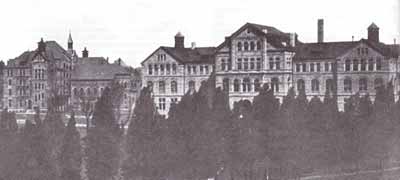
The Catholic University of America, Washinton, DC
There is no doubt that John Ireland was a spellbinding orator. He wove his magic repeatedly from his pulpit in St. Paul; he wove it at Baltimore in 1884 and 1889; and he was to weave it repeatedly in the 1890s, before students' clubs in Paris, at the Congress of Religions during the Chicago World's Fair, and before American seminarians at the North American College. His effect on an audience was perhaps best illustrated when he spoke extemporaneously at the silver jubilee for Bishop John Hennessy of Dubuque, IA. Before about 250 clergy at a festive dinner he responded to a toast, "Our Church and our Country":
Joined with a peculiar intensity of voice and manner, the burning words of the great Bishop of St. Paul went home to every heart, and made each aglow with love of Church and Country, patriotism and virtue....When the Archbishop sat down, a perfect storm of cheering rent the air, amid which a young Priest jumped on a chair and screamed at the top of his voice: "God bless the mother that bore you and the breast that gave you suck."14
Ireland's oratorical prowess led Cardinal Gibbons to ask the Archbishop to preach at the ceremony in the Baltimore Cathedral on November 10, 1889, commemorating the centenary of the American hierarchy. The theme was similar to "The Speech" of 1884 but this time "the tone was firmer, the manner more confident, the rhetoric somewhat more controlled." Ireland began with a paean to the world in which he lived: "I love my age. I love its aspirations and its resolves. I revel in its feats of valor, its industries, and its discoveries....I seek no backward voyage across the sea of time; I will ever press forward." Then he reminisced about an America where "an immigrant boy from County Kilkenny, without a farthing in his pocket, could grow into a man who walked into the White House by the front door to confer with the President of the United States." (A few days after this speech Ireland was to meet with President Benjamin Harrison to discuss how policies of the Bureau of Indian Affairs affected Indians in Minnesota). Although Ireland spoke for nearly 90 minutes, his biographer assured readers that "what he said in Baltimore in 1889...did not differ in essence or even in nuance from the decrees of the Council of Trent." The following excerpts would be included in the "essence or nuance" of what he said:
I bid you, turn to the future. The past our fathers wrought; the future will be wrought by us. As we will it, so shall the story be.
I believe that God intends the present to be better than the past, and the future to be better than the present.
We cannot but believe that a singular mission is assigned to America, glorious for itself and beneficent to the whole race, the mission of bringing a new social and political order, based more than any other upon the common brotherhood of man, and more than any other securing to the multitude of the people social happiness and equality of rights.
In all truth, the greatest epoch of human history, if we except that which witnessed the coming of God upon earth, is upon us; and of this epoch our wisdom and our energy will make the Church supreme mistress.
As a religious system, Protestantism is in process of dissolution; it is without value as a doctrinal or a moral power, and it is no longer a foe with which we need to reckon.15
From Baltimore in 1889 Ireland traveled to Washington where he met with President Harrison and helped Gibbons and Keane dedicate the first building at the Catholic University of America. It was time that the American brand of heresy, in Cardinal Gibbons' felicitous phrase, "blossoms like the rose."
Dr. Justin Walsh has an undergraduate degree in Journalism and a Master's degree in History from Marquette University and a doctorate in History from Indiana University. He spent 18 years as a university professor before resigning from teaching because of the deterioration of university standards in morals and academics. He currently teaches at the Society of Saint Pius X's St. Thomas Aquinas Seminary, Winona, MN, USA.
Footnotes
1. For the colonization scheme and other business dealings with Hill, see Marvin O'Connell, John Ireland and the American Catholic Church (St. Paul, Minn.: Historical Society Press, 1988), pp. 159-163, 375-378.
2. Ibid., pp. 263-264.
3. For the Council, ibid., pp. 121-125.
4. Ibid., pp. 288-289; see also Charles Maignen, Fr. Hecker: Is He a Saint? (London: Burns & Oates, 1898), p. 5.
5. For the speech, see Marvin O'Connell, John Ireland, pp. 192-195; for Gibbons' Thanksgiving Day pastoral, see Francis B. Thornton, Our American Princes: The Story of the Seventeen American Cardinals (New York: G. P. Putnam's Sons, 1965), p. 57.
6. As quoted in John Tracy Ellis, American Catholicism (Chicago: University of Chicago Press, 1955) p. 116.
7. For work of Keane and Denis O'Connell, see Marvin O'Connell, John Ireland, p. 273.
8. Acts of the Council are summarized in Anson Phelps Stokes and Leo Pfeffer, Church and State in the United States (New York: Harper and Row, 1964), pp. 220 ff.
9. Marvin O'Connell, John Ireland, p. 191.
10. Ireland's letter and Hecker's article as cited in Maynard, Catholicism, p. 512.
11. Stokes and Pfeffer, Church and State in the United States. p. 221. Canon Stokes was rector of the Episcopal Cathedral in Washington, D.C., and Leo Pfeffer was a lawyer for the Jewish Anti-Defamation League and represented the American Civil Liberties Union in several cases involving separation of Church and State.
12. For Gibbons' address see Isaac Hecker, The Church and the Age (New York: Paulist Press, 1887), pp. 100-102.
13. Marvin O'Connell, John Ireland, p. 255 and note 67, p. 556.
14. As recounted in ibid., p. 316.
15. For the speech, Marvin O'Connell, John Ireland, pp. 279-283.
